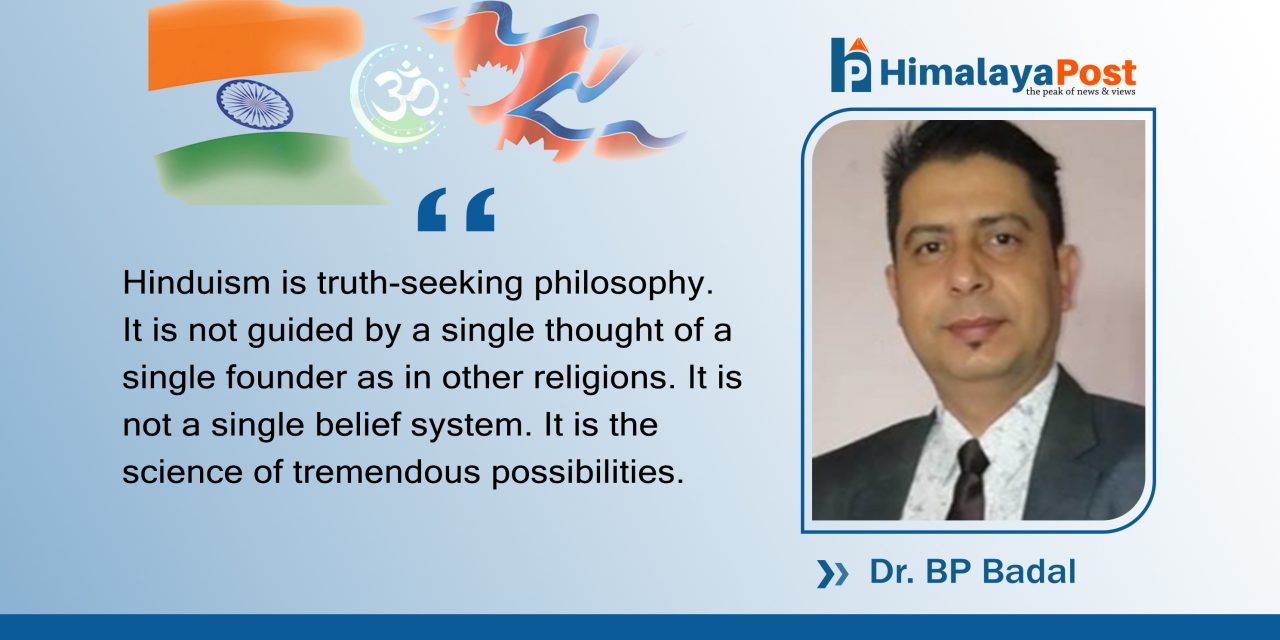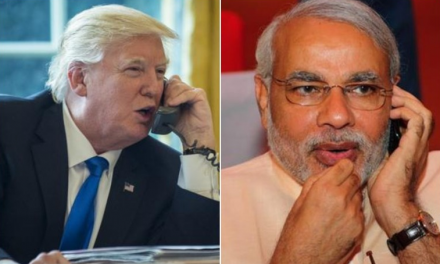– BP Badal
Gods in Nepal and India
Whatever we see or feel in this universe, that births, grows, and dies. Birth, Growth, and Death are the universal truths of the universe. The phenomenal science of the birth is the Generation, of the growth is Operation, and of the death is Destruction. It is popularly known as Srishti, Sthiti, and Pralaya denoted by Brahma, Vishnu, and Mahesh. Every molecule on the planet, whatever we can imagine, has to be generated, has to be operated on, and has to Die. Everything has to go by these three dimensions Generation, Operation, and Destruction. So it is a proven fact that GOD is everywhere.
To create something, it needs Knowledge, to operate something to grow it needs Wealth, and to destroy something it needs Power. Generation needs Knowledge. The operation needs Wealth, and Destruction needs Power. Generation (Brahma) needs Knowledge (Saraswati) to generate. Operation (Vishnu) needs Wealth(Laxmi) to operate or maintain the generation. Destruction (Shiva) needs Power (Shakti) to destruct or nullify the generation. These six dimensions of life are the manifestation of GOD. A successful life must be blessed by Generation, Knowledge, Operation, Wealth, Death and Power. Thus the science of successful life is Hinduism. Those personifications of Generation (Brahma), Knowledge (Saraswati), Operation (Vishnu), Wealth(Laxmi), Destruction (Shiva), and Power (Shakti) are the Gods and Goddesses in Nepal and India.
Hinduism- Sanatan Dharma
Hinduism is not a religion. It is Dharma. It is a prominent philosophy of Human Civilization that emerged and flourished between the Himalayas and the Indian Ocean. Hinduism is an integrated civilization of Indus, Ganga, Brahmaputra and like such based on river basins in South Asia. Hinduism is a set of history in contemporary practice. More specifically, it is a practical history. It is the extension of the Indus and Mohenjo-Daro civilizations including the Dravidian philosophy of the south. There are not any caste and kin discriminations in pure Addhwait Hinduism. Everything comes from nature- a black hole and everything goes to nature- the black hole. There is no self but all of us are simply family members of nature. There are parents, siblings, pets, plants etc. in a family, exactly in the same way, we are universally a family everything we see are our siblings. Although there are thousands of thoughts from six aesthetic and three atheistic philosophies and all those thoughts can be unified in Addhwaita Vedanta.
The six aesthetic philosophies are Vaishesika by Kanad, Nyaya by Gautama, Samkhya by Kapila, Yoga by Patanjali, Purva Mimansa Jaimini and Vedanta or Uttara Mimansa by Vyasa or Badarayan. The three atheistic philosophies are Charvak(Lokayat) by Brihaspati, Jainism by Tirthankar Rishavdev and Buddhism by Gautam Buddha. All these nine philosophies are unified by Adi Shankaracharya in Bishistha Addhwaita Vedanta Philosophy.
Hinduism is truth-seeking philosophy. It is not guided by a single thought of a single founder as in other religions. It is not a single belief system. It is the seeking of truth. It is the science of tremendous possibilities.
Sanatan Dharma worships entire organisms or entire entities as a single family. It gives the meaning of life as Satchitananda – truth, consciousness, and bliss. It gives the four goals of human life – Dharma (Social Welfare), Artha (Economic Welfare), Kaam (Family Welfare), and Mokshya (Blissful Renunciation). It is the science of Bramhagyan– an eternal truth.
In Hinduism dog is a dog, a cat is a cat, a man is a man, a woman is a woman, entire entities are part of God, super soul – no discrimination at all we are all siblings. Shankar, Vishnu, Ram, Krishna, Buddhas, and Rishis, including the entire godly soul, are God. We are all God. Tatwamasi – the god is you. Ahambramhasmi– I am the God. According to the great philosopher Descartes, ‘I think, so I am’. It is not possible to think of a supreme godhead, however, we can think of ourselves as a superman like Arjuna in Mahabharata’s Bhagavad-Gita. Only a single Bhagavad-Gita is enough for the entire Hindu philosophy. The Bhagavad-Gita is the best book from every aspect of humanity. It is not a religious text but a book of human psychological quests and motivations. Bhagavad-Gita is the science of Yoga (Gyan, Bhakti, Karma). Thus Krishna says to Arjun, “Yogi Bhavarjuna”- Be a yogi Arjun. Simply we as human beings have to perform our assigned duty as Arjun did according to the guidance of Krishna in the Bhagavad-Gita. Everything under the sun is a family and everything is possible. There is not any proof of the existence or nonexistence of the soul, so anyone can be a believer or disbeliever. It is freedom but the heart and mind must be peaceful, and blissful. It was since the beginning and will be till the end. Thus it is a Sanatan Dharma.
Religious Disputes
After the influence of King Ashoka in the 3rd century BC, south and East Asia was gloriously influenced by Buddhism. It was a big challenge for some elites and religious leaders of that period and created great disputes. Since then religion entered into politics. In the 9th or 10th century, the disputes were settled by Adi Shankaracharya through the development and interpretation of Addhwait Vedanta. The entire nine philosophies are united and proved that the father of all is GOD. The radical Hindus, Jains, and Buddhists religious political leaders still have some reservations but on the public level, it has great harmony and respect.
The discomfort of religious political leaders made them weak. Hindu, Jain, Buddhist, and other religious political leaders had conflicts with each other. 1000s political states were in existence in South and East Asia with peculiar rivalry. This rivalry became a bliss to the Mughals. The Mughal period was really difficult for the people of the land. Many Hindu Khas Aryans were refugees in Nepal to preserve civilization. It is a pure and old tradition of Hindu civilization that is still preserved in Nepal.
The Veda- the main text or tenant of Hinduism- was compiled and recomposed in Vyas Municipality of Nepal by the well-known sage Veda Vyas. Haridwar, Rishikesh, Badrinath, and Kedarnath were geographically with Nepal. So these holy historical monuments were preserved. Nepal was a strong independent country.
Mughals destroyed 1000s of Dharmik historical monuments. It was a great devastation to local civilization. After the Mughals, the East India Company ruled the land. Muslim and Christianity were promoted but other local indigenous civilizations were in serious ideological traps. Hindu, Jain, Buddhist, and other local religious groups were almost banned from the operation. East India Company forcefully looted Haridwar, Rishikesh, Badrinath, and Kedarnath of Uttarakhand from Nepal in the Sugauli treaty.
In 1947 British left India and Pakistan but did not return the land looted by the British to Nepal. Nepal was expanded above Ganga from Sutlej in the west and the Tishta rivers in the east. Thus especially the Ganga civilization flourished in Nepal. After British rule, western democracy was imposed, and secularism was imposed in India. The land was ruled by Jinnah and Nehru both of them were trained and educated in London. For almost 50 years Nehru and Congress I ruled India. It means that Dharma was in crisis.
In conclusion
There is a popular saying in Nepal. If rains in Delhi, leaders open an umbrella in Kathmandu. The rain of democratic secularism in Delhi impacted Nepal. Congress I deliberately imposed the republic’s secularism. Along with the rise of Modi, the re-establishment of Dharma, was initiated in India. It was not acceptable in Nepal in 2015, because the new constitution with republic secularism was in the final stage of promulgation. However, Modi’s visit had given a vibe to the bilateral relationship but the slow pace of Indian assistance to Nepal created diplomatic problems. Nepal and India both have the same civilization, the same philosophy, the same Dharma, and many more. Both countries must coexist together. Nothing to win and nothing to lose. Modern Nepal was established in 1768 when King Prithvi Narayan Saha won Kathmandu. However present India was established in 1950 when the British left. There are some confusions in Nepal and India’s relations, so both nations must initiate bilateral dialogues as soon as possible to strengthen the diplomatic tie.
(Dr. Badal is Editor in Chief of Research Nepal Journal )





